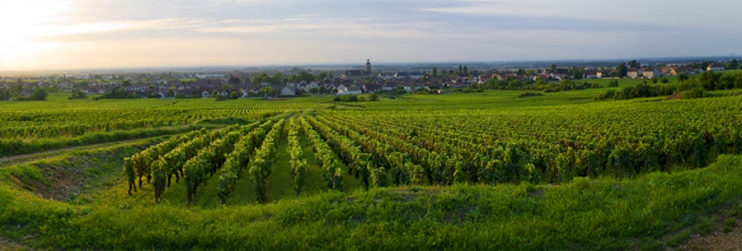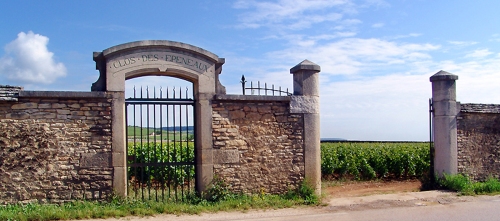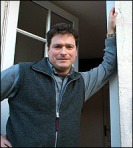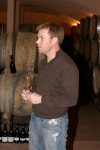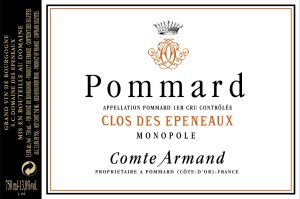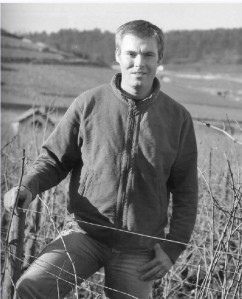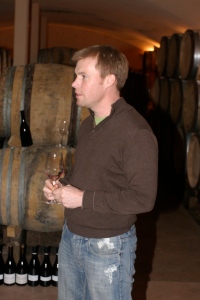Imagining White Burgundy as Major League Baseball, each appellation a competing team, and the winemakers cast as starting pitchers, Meursault would doubtless boast the deepest starting rotation. One needs only to reflect that this appellation includes such outstanding talent as the widely-celebrated Dominique Lafon, the supremely-gifted  Jean-Marc Roulot, and the eagerly-pursued Jean-François Coche. Not to mention superstars Pierre Morey, François Mikulski and Alix de Montille.
Jean-Marc Roulot, and the eagerly-pursued Jean-François Coche. Not to mention superstars Pierre Morey, François Mikulski and Alix de Montille.
Making comparative evaluations among such a galaxy of brilliant winemakers is at the best highly subjective, and at the worst beside-the-point. Nonetheless, given the embarrassment of riches in Meursault, it is striking that at least two of today’s most influential wine writers, were an election held for primus inter pares, might well send up the white smoke for Patrick Javillier. The always perspicacious Clive Coates, who calls Javillier “the King of Meursault,” recently compiled a list of the 10 Top Burgundy Domaines of All Time, awarding one of the coveted spots to Domaine Patrick Javillier. Along the same lines, today’s most influential commentator on Burgundy, Allen Meadows, recently praised Javillier’s 2008 wines as “genuinely brilliant,” then went on to enthuse: “In fact, I would go so far as to say that there is quite simply no one in Burgundy producing better regional or villages level wines across the board.”
Although the Javillier family has resided in Meursault for centuries, they did not make wine until Patrick’s father, Raymond, came back from World War II in 1945. By the time that Patrick took the pipette from his father in 1974, Domaine Javillier comprised a mere 3 hectares, including 2 hecatres of village level Meursault and one of Aligoté.
Currently, Domaine Patrick Javillier consists of 9.5 hectares in the Côte de Beaune, principally in Meursault but also in Savigny-lès Beaune, with additional small plots in Pernand-Vergelesses, Aloxe-Corton and Puligny-Montrachet.The heart of Domaine Javillier lies in Meursault where the Domaine has holdings in six different villages-level climats.
The Domaine’s largest such holding is a 1.5-hectare plot in Les Tillets ,a 12-hectare climat situated uphill and southwest of the village of Meursault toward Puligny-Montrachet. Lying at an elevation averaging 350 meters and enjoying a southeast exposition,with a limestone-based soil, the vineyard manifests a stylistic similarity to the elegantly racy wines of Puligny. Javillier’s oldest vines in Les Tillets were planted in 1937, and the youngest ones in 1977.
The Domaine also holds a 1-hectare parcel of Clos du Cromin, another village-level climat in Meursault that is part of 9.27-hectare Le Cromin that lies in the clay-rich Volnay side of Meursault, adjacent to the Volnay-producing Les Plures.
Intriguingly, Javiller’s most compelling Meursaults are actually each blends of different climats. Contrary to the prevailing orthodoxy in Burgundy, which insists that single vineyard wines are de rigeur, Javillier is a highly  articulate proponent of the philosophy that the whole can exceed the sum of its parts. He vinifies each parcel separately and then carefully evaluates and adjusts the elevage of the individual cask before assembling the final cuvées. Each constituent cask is scrupulously selected for its own characteristics and for its capacity to contribute to the blend. Javillier coaxes complexity into his wines using a combination of batonnage and extended lees contact.
articulate proponent of the philosophy that the whole can exceed the sum of its parts. He vinifies each parcel separately and then carefully evaluates and adjusts the elevage of the individual cask before assembling the final cuvées. Each constituent cask is scrupulously selected for its own characteristics and for its capacity to contribute to the blend. Javillier coaxes complexity into his wines using a combination of batonnage and extended lees contact.
Javillier’s Cuvée Les Clousots is a blend derived from .36-hectare of parcel of Les Clous Dessus and a .23-hectare parcel of Les Crotots. Les Clous Dessus is an east-facing 9.76-hectare climat of Meursault situated at the top of the hill, just to the north of Les Tillets on an east facing slope Javiller’s plot of Les Clous Dessus was planted in 1957 and enjoys deep (1meter) clay-limestone soil over a limestone base. Les Crotots is 4.61 hectare climat of Meursault situated midslope, south of the village, just downhill and to the east of Premier Cru Les Poruzots. Javillier’s parcel of Les Crotots was planted in 1975 on clay-limestone soil with an eastern exposition.
Javiller’s Cuvée Tête de Murger is a rich and complex Meursault blend derived from .62 hectares of vines planted in 1979, partially from Les Casses-Têtes, and partially from Au Murger de Monthelie. The 4.64-hectare Les Casses-Têtes is classic Meusault terroir, east-facing and with very thin soil. The vineyard lies mid-slope in the center of the appellation, just downslope to the east of Les Clous Dessous. The 6.94-hectare climat Au Murger de Monthelie is situated in the northwestern corner of Meursault, toward Volnay, along the border with Monthelie. The climat faces west on a deep (80cm) clay rich soil over a base of volcanic rock. Javillier believes that Les Casses-Têtes contributes minerality and tension on the attack while the Au Murger de Monthelie provides balance, length and opulence on the palate.
Patrick Javillier is particularly renowned for producing what several critics contend is the most remarkable and compelling example of Corton-Charlemagne, surpassing that of even the better known and much larger Bonneau du Martray. Javillier’s tiny .17-hectare south-facing parcel is located in the Grand Cru lieu-dit Les Pougets. Javillier’s vines were planted in 1984.
Perhaps Javillier’s most emblematic wine is his Cuvée des Forgets, which is technically a modestly-classified Bougogne blanc but seems for all intents and purposes (save price!) a full bodied Meursault. Cuvée des Forgets derives from 2.25 hectares of vines within the lieux-dits of Les Herbeux, situated the the northernmost section of Meursault, and Les Vaux, which is located just across the border in Volnay (but nonetheless entitled to the Meursault appellation). The vineyards were planted in the early 1970s and the soils are alluvial limestone over silt.
A similarly celebrated wine is Javillier’s Cuvée Oligocene, which derives from the Meursault climat Les Pellans, which is located in the southernmost section of Meursault adjacent to Puligny-Montrachet. The vineyard lies just south of Meursault Premier Cru Les Charmes-Dessous, but curiously only one-half (6.84 hectares) of the vineyard was legally classified as Meursault after the Great War, despite the fact that the entire vineyard enjoys the same geology, altitude and exposition. Javillier’s .75 hectare parcel of Les Pellans, planted in 1977, is infortuitously situated in the section robbed of its birthright in the original classification. While this obliges Domaine Javillier to label Cuvée Oligocene as Bourgogne Blanc instead of Meursault, the flip-side is that Allen Meadows perennially describes the Cuvée as “genuinely brilliant” and as a “best buy”.
Significantly, Patrick Javillier accords the same care and treatment to his Bourgognes Blancs as he does to his Meursault. That is, he vinifies his Cuvée des Forgets and Cuvée Oligocene and then ages them on lees just as he does his prized Meursault.
Domaine Javillier also produces a very small quantity of Puligny-Montrachet from an .18-hectare parcel of a village-level climat Les Levrons (6.56 hectares), which is located just downhill to the east of Puligny-Montrachet Premier Cru Les Referts. In addition, Javillier makes a miniscule amount of Meursault Premier Cru, Les Charmes, from a tiny plot of .06 hectars Finally, Javillier produces excellent wines from 2 village-level lieux-dits in Savigny-lès-Beaune, a .54 hectare parcel of Les Grands Liards, and a .7 hectare parcel of Les Montchevenoy.
Javillier picks each climat of Chardonnay separately, carefully sorts through the fruit and then presses each separately in Vaslin open tank presses (as opposed to closed tank pneumatic presses that are more common today). . As Remington Norman observes, this eccentric system results in more oxidative winemaking since not only is the tank more open to the atmosphere than with a pneumatic bladder press, but also the must is more fully  exposed to oxygen as it runs along the length of the press. Javillier is willing to sacrifice some of the primary fruit aromas in exchange for the more rapid development of secondary and tertiary aromas in bottle. It may also be that this process helps guard against the premature oxidation that seems to afflict may winemakers who use more anaerobic presses. Javillier’s wines, for whatever reason, do not exhibit the premature oxidation that curses too many contemporary white Burgundies.
exposed to oxygen as it runs along the length of the press. Javillier is willing to sacrifice some of the primary fruit aromas in exchange for the more rapid development of secondary and tertiary aromas in bottle. It may also be that this process helps guard against the premature oxidation that seems to afflict may winemakers who use more anaerobic presses. Javillier’s wines, for whatever reason, do not exhibit the premature oxidation that curses too many contemporary white Burgundies.
After a 24-hour débourbage (“settling”), the must is racked into barrels (25% new oak) where the wines undergo alcoholic and malolactic fermention, and age on their lees for 11-12 months. Unlike many of today’s best winemakers, Patrick is a proponent of batonnage (“stirring the lees”), which he believes enriches the wine and adds complexity. On the other hand, batonnage is presumably be oxidative for two reasons. First, merely removing the bung allows air (and thus oxygen) to enter the barrel and fill up any empty space caused by evaporation. Secondly, the actual stirring physically stimulates the release of free SO₂ and CO₂ , which gasses, trapped in solution in the wine, are believed to retard oxidation.
The white wines rest in the barriques until just before they are needed for the subsequent vintage (usually 11-12 months) at which time each cask is evaluated. Javillier then makes selections based on the characteristics of each cask and assembles his cuvées and decants them into cement vats where they rest for an additional 3-5 months. Javillier believes that the porosity of the cement allows a gentle exchange of air through the walls of the vat, thereby enriching the wines. Again, Javillier is rejecting the prevailing preference for stainless in favor of a the presumably more oxidative cement. Following light fining and (if necessary) filtration, the wines are bottled 14-18 months after harvest.
Thus, Javillier’s open tank pressing, his batonnage, and the final élevage in cement run counter to prevailing practices in Burgundy which tend to reject practices thought to be oxidative. Nevertheless, either because of or inspite of these disfavored practices, it remains noteworthy that Javillier wines have been entirely free of premature oxidation.
Although best known for his white wines, Patrick Javillier also makes superb Pinot Noir, most characteristically a Premier Cru Savigny-lès-Beaune, Les Sepentières. Javillier’s parcel is comprised of .71 hectares of vines planted in 1979 with full south exposure. The soil is limestone-based and very stony. The reds are 100% de-stemmed and then cold macerated for 5 or 6 days. They are vinified in oak barrels, of which 50% are new, and then aged for 11-15 months. The press wine is separated, vinified and aged separately, and added to the final blend if appropriate to the vintage. The reds are neither fined not filtered before bottling. Increasingly, Patrick’s daughter Marion is assisting in the winemaking of the reds.

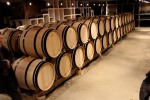 Bachelet adheres to a noninterventionsist philosophy in his winemaking, choosing to allow the vintage to express itself through the Pinot Noir. Accordingly, he eschews modernist techniques and takes a decidedly traditional approach to winemaking. After meticulous triage on a vibrating sorting table, the grapes are completely de-stemmed, lightly crushed, and then cold macerated in cement vats at 15°C. for 5 or 6 days. Natural yeasts then ferment the must for up to two weeks, with the temperature regulated below 32°C. Bachelet generally punches down once or twice daily, but only rarely pumps over. After fermentation, and pressing (pneumatic press), the juice is placed into stainless tanks to settle out the gross lees for up to a week, racked into barrels and then cooled to 13°C. The intent of this cooling is to delay malolactic fermentation for as long as possible, as late as the following August, thereby maintaining high levels of CO₂ and preserving freshness.
Bachelet adheres to a noninterventionsist philosophy in his winemaking, choosing to allow the vintage to express itself through the Pinot Noir. Accordingly, he eschews modernist techniques and takes a decidedly traditional approach to winemaking. After meticulous triage on a vibrating sorting table, the grapes are completely de-stemmed, lightly crushed, and then cold macerated in cement vats at 15°C. for 5 or 6 days. Natural yeasts then ferment the must for up to two weeks, with the temperature regulated below 32°C. Bachelet generally punches down once or twice daily, but only rarely pumps over. After fermentation, and pressing (pneumatic press), the juice is placed into stainless tanks to settle out the gross lees for up to a week, racked into barrels and then cooled to 13°C. The intent of this cooling is to delay malolactic fermentation for as long as possible, as late as the following August, thereby maintaining high levels of CO₂ and preserving freshness.